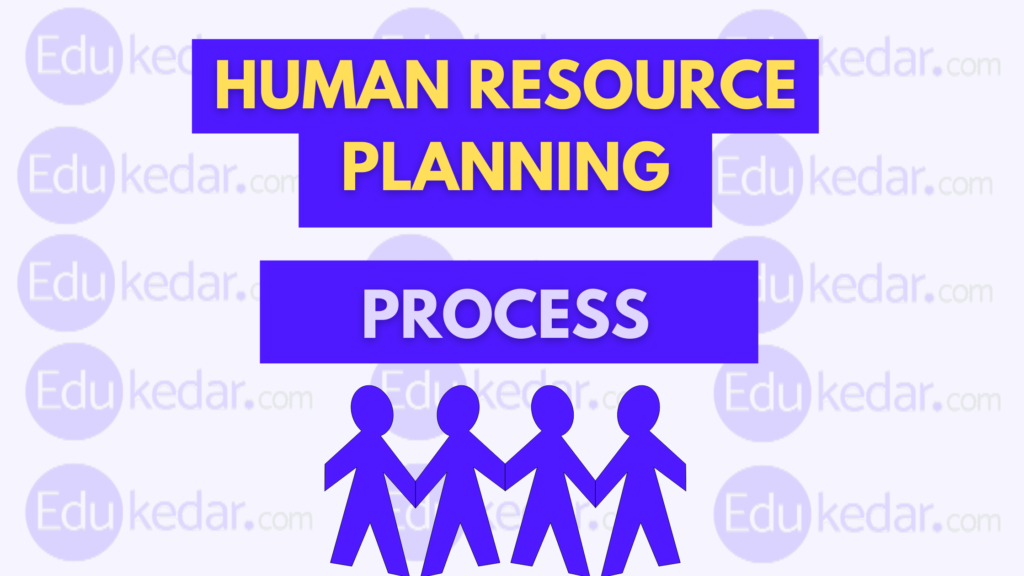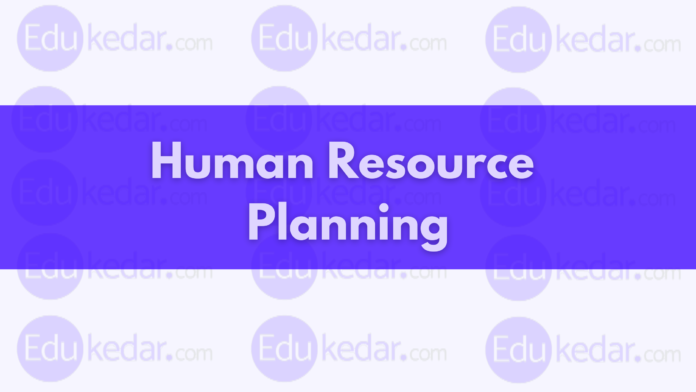Human Resource Planning, in short HRP, basically deals with forecasting additional human resources required in an organization in the future. HR planning is required for all business and non-business organizations.
HRP stands for Human resource planning, it is also known as Manpower planning. It is a starting point in the staffing function of management.
In this article, we have shared complete notes about Human Resource planning and its definition, Importance, and HRP process in the easiest way possible.
Although HR planning means different things to different individuals, general agreement exists on its ultimate objectives, the most effective use of scarce talent in the interest of the labor and the organization.
This statement suggests that there is a lack of agreement on the contents of HRP. Therefore, in order to conceptualize HRP and its contents, let’s go through some definitions.
Definition of Human Resource Planning
Human Resource Planning can be defined as foreseeing the human resource requirement of an organization and the future supply of the human resources.
According to Eric W. Vetter,
‘HR / Manpower Planning is the process by which management determines how the organization should move from its current manpower position to its desired manpower.’
Mr. Coleman has defined human resource planning as,
‘The process of determination of HR/manpower requirements and means of meeting the requirements in order to carry out the integrated plan of the organization.’
Thus, HR planning is a strategy for the acquisition, utilization, improvement, and preservation of the manpower resources of the company.
Human Resource planning in HR Management strives to have the right number and right kind of people at the right places at the right time.
HR Managers perform Human resource planning that results in both the organization and the individual receiving the maximum long-run benefit.
Objectives of Human Resources Planning
The important objectives of manpower planning in an organization are as follow;
- To recruit and retain the manpower of required quantity and quality.
- To make the arrangements for minimizing turnover in the future and filling up of consequent vacancies.
- To meet the needs of the program of expansion and diversification.
- To foresee the impact of technology on work, existing employees, and future requirements.
- To improve the standard of skill. knowledge, ability, and discipline.
- To analyze the surplus or shortage of human resources and take measures accordingly.
- To maintain congenial industrial relations by maintaining the optimum structure of human resources.
- To minimize imbalances caused due to non-availability of human resources of the right kind, right number at the right time, and right place.
- To make the best use of its human resources.
- To estimate the cost of human resources.
Must Read ➜ Roles of Managers
All human resource and staffing activities start with human resource planning. So we can say that human resource planning is the first and foremost activity of human resource management.
Importance of Human Resource Planning
Manpower planning or HR Planning plays a very important role in the organization.
It is very important for an organization to conduct HR planning from time to time as per the requirement. Because without Human resource planning, an organization may become the victim of excessive manpower or a deficient supply of manpower.
In particular, manpower planning contributes in the following ways in managing human resources in an organization;
- Defining Future Personnel Needs
- Coping with Changes
- Providing Base for Developing Talents
- Increasing Investment in Human Resources
- Forcing Top Management to involve in Staffing
Process of Human Resource Planning (HRP)

Human Resource Planning is a process it proceeds through interrelated activities. HRP process is quite comprehensive and covers many functions related to staffing besides human resource planning.
Must Read ➜ Levels of Management
The actual process of human resource planning has been given below.
HRP Process
- Determining organizational objectives
- Forecasting Human Resource Requirements
- Preparing Manpower inventory
- Identification of manpower gap
- Designing Action plans
- Training and Development
- Evaluation and Monitoring of manpower
Organizational objectives and plans provide a base for manpower planning so that it is linked with the former.
Let’s discuss HRP Process in a detailed manner;
1. Determining Organisational Objectives and plans
The first activity at the beginning of an organization is setting objectives that generate various plans and policies that provide direction for future course of action.
Organizational Policies with regard to effective utilization of human resources should be identified and incorporated into the planning process.
2. Forecasting Manpower Requirement
The first essential ingredient of human resource planning is forecasting the needs for human resources in an organization over a period of time.
In one way, we can say that it depends on the scale of operations of the organization over a period of time.
To a great extent, it is true, However, total human resource needs do not have a completely linear relationship with the volume of operation.
This happens because there are factors that affect this relationship such as a change in the machine-man ratio, a change in productivity.
Forecasting of human resource or manpower requirements serves the following purposes;
- To identify what staff mix is desirable in the future.
- To prevent shortages of skilled people where and when they are needed most.
- To monitor compliance with the legal requirements with regard to reservation of jobs.
- To assess appropriate staffing hierarchy in different parts of the organization.
3. Preparing Manpower Inventory
Inventory is a term that is normally used for the counting of tangible objects like stocks and raw materials, finished goods, etc. In the same way, an inventory of human resources can also be prepared.
However, human resources inventory is not simply counting heads that are presently available but cataloging their present and future potential.
Total human resources of an organization are classified as managerial and non-managerial inventories.
- A skills inventory is related to non-managerial personnel and
- A management inventory is related to managerial personnel.
Skills Inventory: usually, in a skill inventory, the following types of information are included;
- Employee’s personal data
- Skills – education, job experience, training
- Special achievement if any
- Salary, Job history
- Potential of the employee
Management Inventory: A management inventory includes the following information;
- Personal data
- Work history
- Strengths and weaknesses,
- Career plan
- Promotion potentials,
- Number and types of employees managed
Must Read ➜ Management Definitions and Basics
4. Identification of Human Resource Gap
The manpower gap is the difference between manpower required at a particular time and the personnel being available at that particular time.
This gap can be identified on the basis of the forecast for human resources needs and supply.
This gap should be measured in respect of various types of personnel because a more aggregate quantitative gap would not serve many purposes.
This gap may be of two types;
- Surplus human resources and
- Shortage of human resources
Based on analysis action plan must be developed to overcome this gap.
5. Action plans
Various action plans are devised to bridge the human resource gap.
If there is a surplus of human resources either because of improper manpower planning in the past. And it may be because of changes in the organizational plans such as divestment of business or closing down some businesses because of various reasons.
Action plans may be devised to prune their size through a layoff, voluntary retirement, etc.
if there is a shortage of human resources, action plans may be devised to recruit additional personnel.
6. Training and Development
Training helps to improve the skills of all employees according to the various job roles and positions.
This program is designed in such a way so that the current skills of employees can match the requisite skills for the achievement of objectives.
7. Evaluation and Monitoring of manpower
The final step in Human resource planning is monitoring and evaluation of this whole HRP process. In this parameter, the effectiveness of whole human resource planning is checked.
This evaluation ensures that whether the deficiency and surplus of employees are fulfilled or not. In case of any unfavorable situation, appropriate steps are taken time to overcome them.
It helps in determining performance standards against which the actual job performance is measured.
Must Read ➜ Management by Objectives (MBO)
Benefits of Human Resource Planning
Here are the advantages or benefits of Human Resource Planning;
- Create Reservoir of Skills and Talent,
- Preparation for future HR requirements,
- Promote employees in a systematic manner,
- Provide the basis for HRD,
- Heps in career and succession planning,
- Helps in planning job assignments,
- Helps cope with fluctuations in staffing,
- Identifies recruiting needs,
- Provides other useful information





